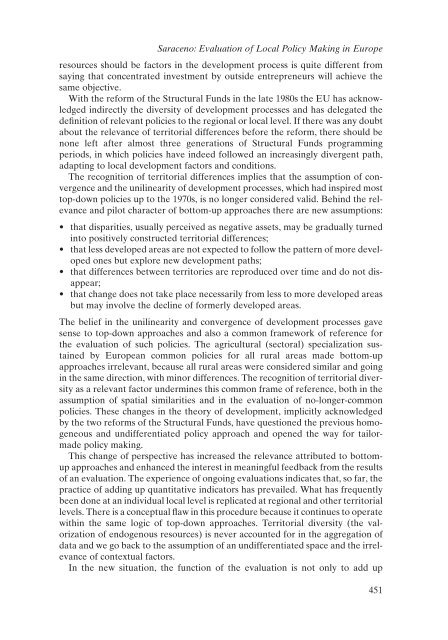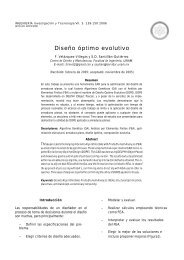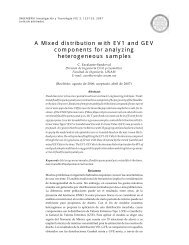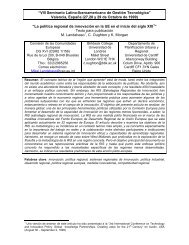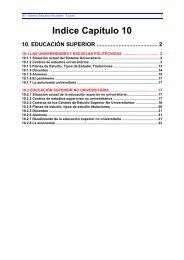The Evaluation of Local Policy Making in Europe - OEI
The Evaluation of Local Policy Making in Europe - OEI
The Evaluation of Local Policy Making in Europe - OEI
You also want an ePaper? Increase the reach of your titles
YUMPU automatically turns print PDFs into web optimized ePapers that Google loves.
Saraceno: <strong>Evaluation</strong> <strong>of</strong> <strong>Local</strong> <strong>Policy</strong> <strong>Mak<strong>in</strong>g</strong> <strong>in</strong> <strong>Europe</strong><br />
resources should be factors <strong>in</strong> the development process is quite different from<br />
say<strong>in</strong>g that concentrated <strong>in</strong>vestment by outside entrepreneurs will achieve the<br />
same objective.<br />
With the reform <strong>of</strong> the Structural Funds <strong>in</strong> the late 1980s the EU has acknowledged<br />
<strong>in</strong>directly the diversity <strong>of</strong> development processes and has delegated the<br />
def<strong>in</strong>ition <strong>of</strong> relevant policies to the regional or local level. If there was any doubt<br />
about the relevance <strong>of</strong> territorial differences before the reform, there should be<br />
none left after almost three generations <strong>of</strong> Structural Funds programm<strong>in</strong>g<br />
periods, <strong>in</strong> which policies have <strong>in</strong>deed followed an <strong>in</strong>creas<strong>in</strong>gly divergent path,<br />
adapt<strong>in</strong>g to local development factors and conditions.<br />
<strong>The</strong> recognition <strong>of</strong> territorial differences implies that the assumption <strong>of</strong> convergence<br />
and the unil<strong>in</strong>earity <strong>of</strong> development processes, which had <strong>in</strong>spired most<br />
top-down policies up to the 1970s, is no longer considered valid. Beh<strong>in</strong>d the relevance<br />
and pilot character <strong>of</strong> bottom-up approaches there are new assumptions:<br />
• that disparities, usually perceived as negative assets, may be gradually turned<br />
<strong>in</strong>to positively constructed territorial differences;<br />
• that less developed areas are not expected to follow the pattern <strong>of</strong> more developed<br />
ones but explore new development paths;<br />
• that differences between territories are reproduced over time and do not disappear;<br />
• that change does not take place necessarily from less to more developed areas<br />
but may <strong>in</strong>volve the decl<strong>in</strong>e <strong>of</strong> formerly developed areas.<br />
<strong>The</strong> belief <strong>in</strong> the unil<strong>in</strong>earity and convergence <strong>of</strong> development processes gave<br />
sense to top-down approaches and also a common framework <strong>of</strong> reference for<br />
the evaluation <strong>of</strong> such policies. <strong>The</strong> agricultural (sectoral) specialization susta<strong>in</strong>ed<br />
by <strong>Europe</strong>an common policies for all rural areas made bottom-up<br />
approaches irrelevant, because all rural areas were considered similar and go<strong>in</strong>g<br />
<strong>in</strong> the same direction, with m<strong>in</strong>or differences. <strong>The</strong> recognition <strong>of</strong> territorial diversity<br />
as a relevant factor underm<strong>in</strong>es this common frame <strong>of</strong> reference, both <strong>in</strong> the<br />
assumption <strong>of</strong> spatial similarities and <strong>in</strong> the evaluation <strong>of</strong> no-longer-common<br />
policies. <strong>The</strong>se changes <strong>in</strong> the theory <strong>of</strong> development, implicitly acknowledged<br />
by the two reforms <strong>of</strong> the Structural Funds, have questioned the previous homogeneous<br />
and undifferentiated policy approach and opened the way for tailormade<br />
policy mak<strong>in</strong>g.<br />
This change <strong>of</strong> perspective has <strong>in</strong>creased the relevance attributed to bottomup<br />
approaches and enhanced the <strong>in</strong>terest <strong>in</strong> mean<strong>in</strong>gful feedback from the results<br />
<strong>of</strong> an evaluation. <strong>The</strong> experience <strong>of</strong> ongo<strong>in</strong>g evaluations <strong>in</strong>dicates that, so far, the<br />
practice <strong>of</strong> add<strong>in</strong>g up quantitative <strong>in</strong>dicators has prevailed. What has frequently<br />
been done at an <strong>in</strong>dividual local level is replicated at regional and other territorial<br />
levels. <strong>The</strong>re is a conceptual flaw <strong>in</strong> this procedure because it cont<strong>in</strong>ues to operate<br />
with<strong>in</strong> the same logic <strong>of</strong> top-down approaches. Territorial diversity (the valorization<br />
<strong>of</strong> endogenous resources) is never accounted for <strong>in</strong> the aggregation <strong>of</strong><br />
data and we go back to the assumption <strong>of</strong> an undifferentiated space and the irrelevance<br />
<strong>of</strong> contextual factors.<br />
In the new situation, the function <strong>of</strong> the evaluation is not only to add up<br />
451


